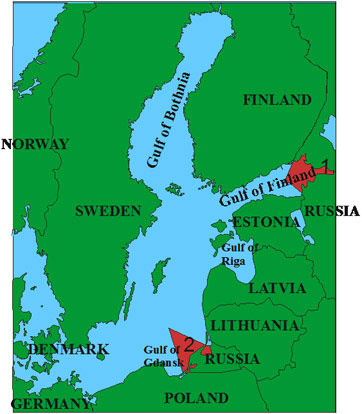
GULF of FINLAND
Two Russian zones of the Baltic Sea – hot spots of our interest
EEZ of Russia, Finland and Estonia close up in the Gulf of Finland, this makes the Gulf of Finland a junction of political, economical, cultural relationships, as well as the greatest transport corridor connecting East and West, that is at the same tine an area of interacting vital activity and and life support for Baltic nations.
Natural regional peculiarities of the eastern
Gulf of Finland:
- the Gulf of Finland is situated within the connection zone between
the Baltic Shield and Russian Plate, this position determines
specific of tectonic regime and geological history of the Region;
- geological “youth” of the Gulf of Finland leads to active dynamics and
continuing evolution of marine and coastal landscapes;
- some processes and phenomena of endogenous and exogenous geodynamics
of natural geological development of the eastern and northern part
of the Gulf of Finland can be classified as geological hazards;
- the eastern Gulf of Finland is a giant estuary of the Neva River and
is characterized with expressed natural gradients and impacts
(salinity, temperature, mosaic benthic relief, currents, inflows,
coastline etc. );
- peculiarities of biodiversity and biological resources of the eastern
Gulf of Finland are determined by relative “youth” of the
ecosystems, its estuarine nature, climate.
Anthropogenic impacts and peculiarities of
resource use:
- global climate changes;
- shipping and related impacts (bioinvasions, oil spills, sea port
constructions, new harbors and terminals construction, sea-port
exploitation, ship-ways dredging etc.);
- construction and exploitation of the North-European Gas Pipe and other
communications - wates disposal (sea and land);
- high concentration of population with economical and social
infrastructure within adjacent areas causes related impacts: (eutrophication
and accumulation of pollutants within different components of
ecosystem, habitat deterioration, fishery, mines, hydrotechnical
impacts, multicomponent technogenic impacts in the sea floor, water
masses, coasts etc. );
- during last three centuries the Gulf of Finland has been an area of
military conflicts and navy activity, so there are a lot of
potential hazardous objects on the bottom surface and in the upper
sediment layer.
Other:
- expanding of hypoxic/anoxic zones;
- changes of near-bottom hydrochemical conditions in sedimentation
basins that may result in potential secondary pollution (heavy
metals, nutrients etc.) of the Gulf of Finland.
